I would rate red mites as being one of the biggest problems you will face when keeping chickens. Red Mites live in the cracks of chicken houses (typically under perch ends) coming out at night, crawling onto your birds for a feed.
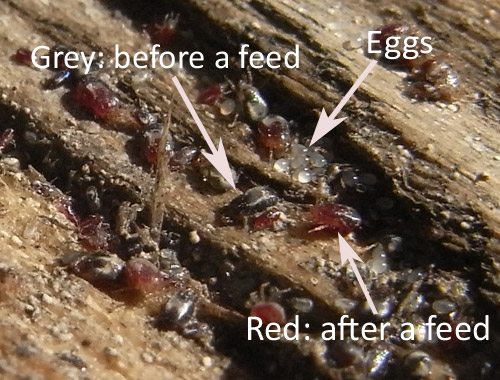
Macro shot of Red Mite in a crack on a perch. These were disturbed after a treatment with Poultry Shield.
They start off as very small greyish-white mites that swell up into red coloured mites after a feed and at their biggest are only 1mm so small numbers of them can be hard to spot unless you know what to look for.
You will often find a grey ash like deposit around perch ends which is where the mites have been and if you lift the perch, you will see clumps of mites.
Red Mite in chickens’ houses are active during the warmer months, usually May to October and will become dormant over the winter. They multiply at an incredible rate: their life cycle is just 7-10 days. In other words from hatching from an egg to being an adult laying hundreds of eggs takes just a week if conditions are right.
Be Proactive.
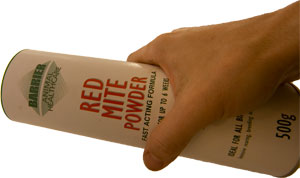 The best course of action is to check for red mite routinely when you clean your chicken house out and use some preventative treatment to the house before they get a hold. You will get to know the places to look and once you have found small numbers of them, you can treat the house to keep numbers under control. See my ‘preventative measures’ below
The best course of action is to check for red mite routinely when you clean your chicken house out and use some preventative treatment to the house before they get a hold. You will get to know the places to look and once you have found small numbers of them, you can treat the house to keep numbers under control. See my ‘preventative measures’ below
Are there Red Mite in your Chicken House?
People normally discover Red Mite when they are over-run by them. When hens are being bitten, they can refuse to go in to roost at night, they will become anaemic and their combs will go pale. They will often stop laying and you may find red blood stains on eggs (squashed Red Mites). Eventually, you will start to see losses in the flock.
Checking for Red Mite in Chickens Houses
Red Mite will hide away in the daytime but can often be seen if you lift perches, examining the ends. They will usually come swarming out if you treat the cracks with Poultry Shield but by far the easiest way to check to see if there are red mite is to take a piece of white kitchen roll and to rub it along the underside of the perch when your hens are roosting (in the dark). Look at the tissue and if there are Red Mite heading back from their feed, they will be squashed on the kitchen roll as streaks of blood.
Getting rid of Red Mite
It is very hard to get rid of them completely so it is often better to get the numbers down and then find a way of keeping them down that doesn’t involve you spending hours on cleaning the house out. There are lots of different treatments that people use, some more effective than others but I will focus on what I do and have found to be the most successful for me.
If you haven’t got red mite and the weather is warm enough for them (May to October in the UK) then skip step 1 and go straight to step 2. Preventative Measures.
1. Getting rid of an infestation.
If you find lots of red mite in the coop, it’s time for a big clean up that will take a couple of hours initially, then an hour every 5 to 7 days for at least 2 more weeks.
The products I have found to work the best (that are relatively safe) are Poultry Shield and Diatom. These two are not ‘knock down’ products as such, they do take a little while to work but are none the less very effective. I also use Red Mite Powder on the hens themselves to help them through the night when the Mites are active.
You can BUY Poultry Shield from Amazon Here.
Here is what I do with the Poultry Shield.
- Remove all birds from the house.
- Strip the house down as much as possible.
- Clean the house out – be careful where the bedding is going as red mite live for 6 months without a feed and will find a new home If they can. Ideally seal the bedding in bin bags or burn.
- Mix up as many watering cans of poultry shield mixture as is needed, as per the instructions on the label 1 part to 9 parts water.
- ‘Water’ all cracks in the chicken house, concentrating where there are perch ends and concentrations of red mite.
- Leave to soak for 15 minutes
- Red mites will be coming out. Cover them and the cracks with poultry shield again.
- Wait 15 minutes
- Hose out the house, concentrating on getting the pressure jet into the cracks and so on.
- Leave the house to dry.
Poultry Shield is a mild detergent and ‘washes’ the waxy coat off the red mites. It is also good for removing organic matter from the hen house so is useful for cleaning. I wouldn’t be without this!
After using the Poultry Shield, when the house is dry, I use Diatom. Diatom is made of micro skeletons of fossilised remains of diatoms. These were once a kind of algae found in water. They are microscopically sharp and pierce the outer waxy coating of the mites which causes them to dry out and die.
The second step also double up as my ‘preventative’ measures if you haven’t yet got a bad infestation
You can BUY Diatom from Amazon HERE
2. Preventative Measures
- Dust the ends of the perches / nest boxes and where ever else you found concentrations of red mites when cleaning.
- Rub as much into the perches as you can. Red mite will avoid the diatom and will crawl around it if they can, so make sure they have to crawl through it to get a feed.
- Repeat every couple of days for as long as you see signs of red mite in the coop.
Repeat the whole cleaning process if there are still lots of mites in 5 to 7 days. You will find you might not need to spend as long on the washing as there won’t be as many mites.
Very Important: Make sure you repeat it before 7 days so that the mites don’t have a chance to lay more eggs. A few mites become a lot in a very short space of time!
If you have a felt roof on your chicken house and they get underneath, it is usually impossible to get rid of them without removing the felt, cleaning and re-felting. My page on Chicken Houses gives more information.
Finally, I will dust the hens down between their feathers with Red Mite Powder to give them some respite during the night when the mites are active.
Beware of what you read!
There is a lot of information written about these troublesome ectoparasites on the internet these days, much of it re-written and re-spun. When I started writing about them, there was little available online. Strangely, some small errors that I had introduced on my page that I corrected in an update pop up frequently on other websites. Running a Google image search often uncovers companies that have used my copyrighted images! I make regular checks to try to stop this from happening.
If you wish to learn more about red mite then I would encourage you to read the guide to red mite on poultrykeeper.com. This is a reliable source of information and is regularly updated.

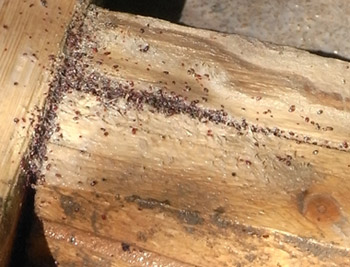

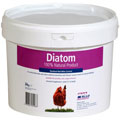

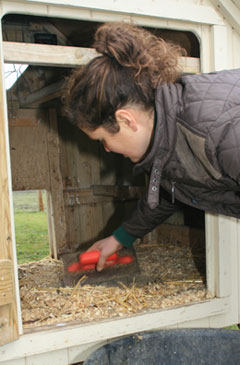
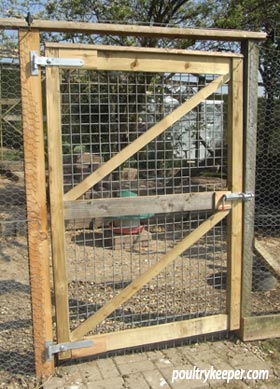
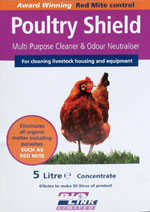
Hi
I have bombed my coop twice now, used the spray, I dust My chickens regularly, I have even taken my steamer to the coop and thoroughly steamed everywhere, BUT they are still there and its starting to affect my Chickens. Please do you have any other ideas of how I can get rid of them as I am thinking of getting rid of my chickens now as its not far to them
Thanks
Hi Lucy,
They key is to manage them rather than try to eradicate them completely. You must repeat treatments in less than weekly intervals because they multiply so quickly, you have to break their life cycle. New eggs hatch, feed and lay more eggs before you’ve had a chance to clean again.
Keep on treating for a few weeks every 5 or 6 days and you should see the numbers drop. If not, there are lots of mites hidden somewhere – possibly under a felt roof or some other inaccessible place. You really need to get at them all if you can to speed the process up.
As the cooler weather comes in, you’ll not see much activity – but continue to treat for a while to get as many of the dormant mites as you can.
Good luck…
Use fairy liquid ( brand of dish washing up liquid, or similar product ) with hot water in quite a strong solution, clean your coop with it, I use a soft brush it gets into all the nooks and crannies, this is very effective, red mite have a waxy shiny coat, the dish wash liquid is a degreaser and damages and can break down their protective coat which kills them, coupled with the heat from the water you’ll probably notice the mites leaving in droves, after the coop has dried and you’ve let your hens back in, wait till nightfall and take a torch with you, have a look on the walls of the coop for any remaining mites, I usually then spot treat areas where I find clusters with neat white vinegar in a spray bottle, unlike dish wash solution it kills on contact, the next day you’ll prob find lots of dead mite stuck where the white vinegar touched them, if you have a really bad infestation I would repeat my method every 5 to 7 days for a 2-3 week period till you only find a few here and there, in between times just use spray bottle with vinegar on smaller clusters, I’ve used a steamer with essential oils in ( toxic to red mite) or steamer on its own it’s very effective especially in hard to reach areas I.e cracks and crevices in wooden coops, hope you find this useful folks
Very useful – thank you Ian 🙂
Lucy,
I had the same problem which went on for weeks but found that once I used Noramectin, which your vet should be able to supply, it sorted the problem out as it paralyses the mite when they feed off your chickens. You only need a couple of drops for each one. It only cost me 33p do treat my 4 chickens so not expensive.
Good luck
Nikki
I believe this contains Ivermectin and can come under a few different names. See this page also:
http://poultrykeeper.com/poultry-medication/ivermectin-for-worms-lice-mites
I recently got chickens mine love to sand bath… is this done for a reason.. like to keep bugs off?
Yes, exactly. It’s called a ‘dust bath’ and together with preening, they do this to clean their feathers and get rid of lice.
I find rubbing Vaseline on the hens legs work very well when affected with mites and have used this method for many years. It acts like a barrier and any mites that get through should suffocate when the jelly covers them. The chicken coop also needs a good clean out.
Can chicks get mites? we have 5, week old chicks which we hatched out in a incubater but I’ve noticed today one keeps shaking its head as if a fly has just landed on it, could it be mites or our they too young they our in a box ,cardboard at moment with a heat lamp the others seem fine
They can if they are exposed to them, but this is unusual.
More likely is a problem in the ear that can cause head shaking. Perhaps a deformity from the hatch.